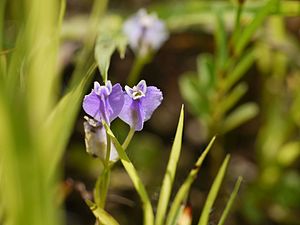Burmannia coelestis
| Burmannia coelestis | ||||||||||||
|---|---|---|---|---|---|---|---|---|---|---|---|---|

Burmannia coelestis |
||||||||||||
| Systematics | ||||||||||||
|
||||||||||||
| Scientific name | ||||||||||||
| Burmannia coelestis | ||||||||||||
| D. Don |
Burmannia coelestis is a species ofthe Burmanniaceae family . It is distributed from southern continental Asia to Australia.
description
Burmannia coelestis is an annual, leaf-green, unbranched to seldom branched herbaceous plant that reaches a height of 10 to 40 centimeters. It is semi-mycotrophic . There is no rhizome , the roots are fibrous and short.
The leaves are linear to lanceolate, pointed, three-veined, 4.5 to 18 millimeters long and 3 millimeters wide. They stand as a down-to-earth rosette, the flat stem leaves are 5 to 31 millimeters long. The inflorescence is a terminal double wrap consisting of two to eight, rarely only one or two flowers . The short-stalked or almost sessile flowers are 10.6 to 14.8 millimeters long and blue to blue-purple with yellow lobes. The flower tube is cylindrical to three-angled and 4.5 to 13 millimeters long, the 1.5 to 3 millimeter wide wings are halved elliptical to halved inverted egg-shaped and run from below the ovary to the middle of the outer flower lobe. The outer lobes are erect, tapering to a point, ovate to ovate-triangular and 1 to 2 millimeters long, the inner membranous, lanceolate and 0.5 to 1 millimeter long. The stamens are sessile and start in the pharynx, the connective has two short, lateral arms that carry the thecae . The stylus is thickened, thread-like and, together with the scars, is as long as the flower tube, at its end are the three almost sessile, trumpet-shaped scars .
The ovaries are elliptical to inverted egg-shaped and 3 to 7 millimeters long. The inverted egg-shaped capsule opens along transverse slits. The seeds are elliptical and yellow.
Dissemination and ethnobotany
Burmannia coelestis is native to Malesia , southern continental Asia and warm regions of Australia and is found in open swampy vegetation at altitudes between 0 and 800 meters.
The Santal in West Bengal reported that the species was used as a medicinal herb.
Systematics
The species was first described by David Don in 1825 .
literature
- Dianxiang Zhang : Systematics of Burmannia L. (Burmanniaceae) in the Old World , pp. 188–197, in: Hong Kong University Theses Online, Thesis (Ph.D.), University of Hong Kong, 1999
Individual evidence
- ^ Fredrik Pieter Jonker: A monograph of the Burmanniaceae , Meded. Bot. Mus. Herb. Rijks Univ. Utrecht 51, 1938, p. 14